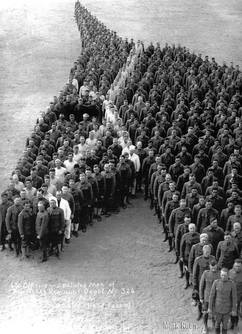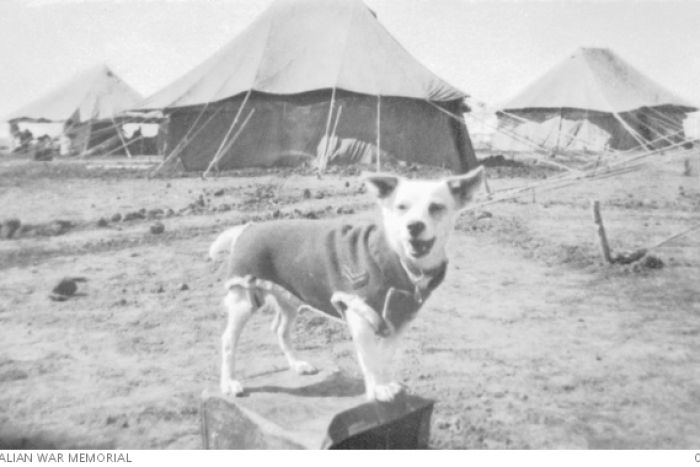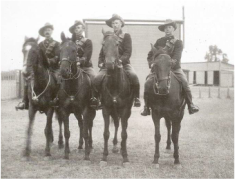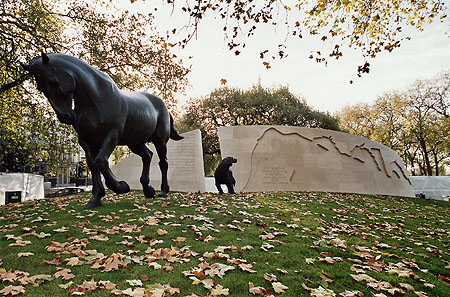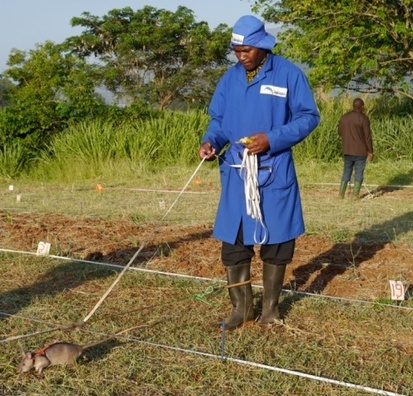Remember The Animals project - completed 2016
|
The Remember the Animals project was completed in December 2016. Thank you to Hobart City Council, the West Hobart Peace Park Community Group and generous community support. The installation recognises the contribution and sacrifice of the many animals that throughout history have been involuntary participants in war. |
|
Did you know?
- Horses were 'reservists'. Millions of these reservists were killed in and immediately following WWs 1 and 2.
- In World War 1, soldiers in the trenches read their orders with the help of glow worm lamps.
- Cats were crucial wartime participants. In trenches, supply depots and hospitals cats prevent rats from eating supplies and spreading disease.
- see more stories below ....
Tribute To lost horses
Horrie
|
Private Jim Moody was in northern Egypt in 1941 when he found a scruffy little terrier. Despite the camp rule against pets, "Horrie" would come to be a vital and adored member of the team and travel with them to Greece, Crete, Palestine and Syria.
"Whenever enemy aircraft was coming Horrie would start barking and they knew to get cover long before they appeared in the sky," author Anthony Hill told ABC News Breakfast. When their time in World War II ended, Private Moody smuggled Horrie back to Australia — but their struggles weren't over. After a few years Down Under, the quarantine authorities found out about Horrie and ordered him to be put down. There were rules to be followed, after all. The story now goes that Private Moody searched the local pounds for a lookalike and it was this poor pup that was put to death, while Horrie lived out his days in regional Victoria. Source: http://www.abc.net.au/news/2017-04-14/how-weve-grown-to-appreciate-our-war-time-animals/8430820 |
Tasmanian Connection
|
Majorie's father's worked with horses in World War 1:
Mervyn Luck left Hobart on 19th October 1914. On the ship HMAT Katuna were 127 horses. Two died on the 7 week 3 day journey. My father’s job was to look after the horses and he records in his diary daily “exercising the horses in the morning, grooming in the afternoon.” On 24th April, he left Lemnos for the Dardanelles and for 20 days looked after the horses on the ship. He went to Alexandria on 14th May with the horses suffering colds. He continued to exercise the horses daily, “took horses to the beach and swam them” until the diary ends on 7th June 1015 after which he went from Egypt to the battle fields of France. The horses did not leave Egypt. Marjorie wonders now - were they shot before he left Egypt? (World War I, in which 10 million soldiers died, also resulted in the deaths of 8 million military horses. http://www.history.com/news/war-animals-from-horses-to-glowworms-7-incredible-facts) |
Animals' Victoria Cross
|
A memorial sculpture in Park Lane in Central London is dedicated to the animals who served and died in conflict and who have received the PDSA Dickin Medal. The Medal was instituted in 1943 in the United Kingdom by Maria Dickin to honour animals in war. It is the animals’ equivalent of the Victoria Cross, and has been awarded to many animals that served and died alongside British and allied forces. Recipients include: Rob, a para-dog who made more than 20 parachute drops while serving with the SAS on top-secret missions in Africa and Italy Ricky, a canine mine-detector who continued with his dangerous task of clearing a canal bank in Holland despite suffering head injuries Winkie, a pigeon that flew 129 miles with her wings clogged with oil to save a downed bomber crew Mary of Exeter, another pigeon, which flew back with her neck and right breast ripped open, savaged by hawks kept by the Germans at Calais. Search and rescue dogs, Beauty, Peter, Irma and Jet, who located survivors buried in the debris of the London Blitz. Metropolitan Police horses, Olga, Regal and Upstart, who faced their fear of fire and the hail of flying bombs. More recent recipients include Buster, a six-year-old Springer spaniel, who won it for his service in Iraq in 2003, when he discovered a hidden cache of explosives in the southern city of Safwan. |
|
Tasmanian PIGEON 139 - Dickin Medal winner
PIGEON 139 was awarded the Dickin Medal posthumously as none of the pigeons came home from the war alive because of quarantine regulations. He was a blue bar cock: slate-grey with two dark bands across his wing.
In July 1945 he had flown 1600m on 23 missions. At that time he was attached to a water transport company at Madang in PNG which ferried supplies to the fighting troops. The ships all had radio, but crews rarely put to sea without a pair of pigeons. On July 12 the ship he was on was well at sea when the vessel rolled in a storm and the engine died. Radio contact was lost and the vessel stuck fast on a sandbar.
Pigeon 139 was launched into the fierce wind and driving rain with a message asking for immediate help. The bird's instinct was to fly low to find shelter from the weather, but too low he would be taken by the sea and drowned. He flew much of the distance over water carrying the extra burden of clinging salt spray and rain soaked feathers. He reached Madang and the crew and cargo of the stranded vessel were saved.
Summarised from a Hobart Mercury article on 22 April 2017, which in turn was an edited extract from Animal Heroes by Anthony Hill.
In July 1945 he had flown 1600m on 23 missions. At that time he was attached to a water transport company at Madang in PNG which ferried supplies to the fighting troops. The ships all had radio, but crews rarely put to sea without a pair of pigeons. On July 12 the ship he was on was well at sea when the vessel rolled in a storm and the engine died. Radio contact was lost and the vessel stuck fast on a sandbar.
Pigeon 139 was launched into the fierce wind and driving rain with a message asking for immediate help. The bird's instinct was to fly low to find shelter from the weather, but too low he would be taken by the sea and drowned. He flew much of the distance over water carrying the extra burden of clinging salt spray and rain soaked feathers. He reached Madang and the crew and cargo of the stranded vessel were saved.
Summarised from a Hobart Mercury article on 22 April 2017, which in turn was an edited extract from Animal Heroes by Anthony Hill.
Gambian RATS Saving Lives In TANZANIA
|
In Tanzania, at the foot of the Uluguru mountains, watched over by men and women clutching bananas and the small clickers, dozens of African giant pouched rats shuttle across taped-off alleyways trying to catch the lingering scent of TNT from some of the 1,500 deactivated landmines that have been sown in the red earth. They scamper back and forth with an apparent mix of delight and concentration, as if they know that each time they find a mine and communicate their discovery with a fit of scratching, they will be rewarded with a click and a mouthful of fruit.
Their forebears have already helped to reclaim millions of square metres of land in Angola and Mozambique - the latter of which is expected to be declared mine-free soon. This cadre of rats could find themselves deployed to Cambodia, to clear up the explosive legacy of three decades of conflict. For the full story see http://www.theguardian.com/global-development/2015/mar/05/heroic-giant-rats-sniff-out-landmines-in-tanzania. |
Resources
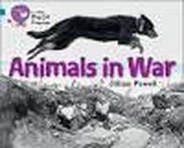
Animals in War- Jillian Powell and the Imperial War Museum (Great Britain) - 2012.
From pigeons and elephants to parachuting dogs - millions of animals helped in both world wars. This nonfiction book focuses on the animals that were involved and their bravery in the face of battle.
From pigeons and elephants to parachuting dogs - millions of animals helped in both world wars. This nonfiction book focuses on the animals that were involved and their bravery in the face of battle.
A is for Animals: the A to Z of Animals in War
Published in 2009 by the Australian War Memorial
Website https://www.awm.gov.au/exhibitions/animals/ includes an Education Kit for schools in downloadable .pdf format.
Published in 2009 by the Australian War Memorial
Website https://www.awm.gov.au/exhibitions/animals/ includes an Education Kit for schools in downloadable .pdf format.
